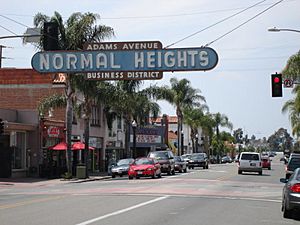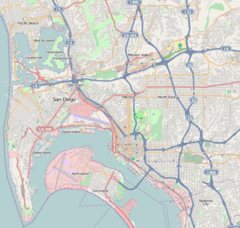Normal Heights, San Diego facts for kids
Quick facts for kids
Normal Heights, San Diego
|
|
|---|---|
| Normal Heights | |

Looking west down Adams Avenue
|
|
| Country | |
| State | |
| County | |
| City | |
Normal Heights is a cool neighborhood in the middle of San Diego, California. It's known for its unique history and lively community events.
Contents
History of Normal Heights
The name "Normal Heights" comes from the State Normal School. This was a special college for training teachers. It was located nearby in University Heights. The school started in 1899. Today, that old school building is the main office for the San Diego Unified School District.
Early Days and Growth
When San Diego was first founded, the area now known as Normal Heights was mostly empty land. It had a lot of brush and was home to many rabbits. Later, a few farms appeared. But it was hard for the area to grow because there wasn't enough water.
In the 1880s, people started to get interested in buying land here. By the early 1900s, several companies were working to develop the area. Around 1905, a large water tank (reservoir) was built in University Heights. This helped Normal Heights grow quickly. The number of buildings jumped from just one in January 1906 to 43 by December of the same year!
Becoming a Community
Normal Heights officially became a community in 1906. A group led by D. C. Collier and George M. Hawley created a map for the new neighborhood. At first, it was its own community, not part of San Diego city.
It became one of San Diego's first "streetcar suburbs." This meant people could easily travel by electric trolley. A trolley line was built along Adams Avenue. A place to keep the trolleys was built in Normal Heights in 1913.
Community Improvements
In 1911, residents formed the Normal Heights Improvement Association. They helped create a public library and other good things for the area. Normal Heights Central School opened in 1912. The county also started paving roads and adding sidewalks in 1913.
A business area grew in the 1920s along Adams Avenue. This area is now called the Carteri Center. It was named after Benjamin J. Carteri, who helped businesses and homes grow there. In 1925, Normal Heights officially became part of the city of San Diego.
Facing Challenges
In June 1985, a wildfire spread into Normal Heights. It came from the hills north of the community. The fire damaged or destroyed 69 homes. Many of these homes had great views of the valley.
Later that year, Normal Heights was a finalist for the "All America City" award. This was partly because neighbors helped each other after the fire. They also worked together to get a city park and a plan to keep the neighborhood from getting too crowded.
Geography of Normal Heights
Normal Heights is located right in the middle of San Diego. It sits on a flat area of land called a mesa. This mesa is just south of Mission Valley.
Neighborhood Borders
The neighborhood has clear boundaries:
- To the west: Interstate 805
- To the north: Interstate 8
- To the east: State Route 15
- To the south: El Cajon Boulevard
Notable Buildings
There are a few interesting buildings in Normal Heights. One is a group of small homes called Santa Rosa Court on Adams Avenue. It was designed by Louis L. Gill. Another is a Carmelite monastery on Hawley Blvd., designed by Frank L. Hope, Sr.
People of Normal Heights
A study in 2001 looked at the people living in Normal Heights. It found that the average age was 31. The neighborhood was made up of about 53% white, 25% Hispanic, 13% African American, and 9% Asian American residents. The San Diego Union-Tribune newspaper reported that Normal Heights was the only neighborhood that perfectly matched the ethnic mix of San Diego city.
Culture and Fun
Normal Heights is a great place for walking around. Many people walk, bike, or use scooters here. This is common in neighborhoods north of Balboa Park.
The part of Adams Avenue between Texas Street and Ohio Street is sometimes called "Antique Row." This is because it has many antique stores. There's also a famous neon sign over Adams Avenue at Felton Street that lights up the neighborhood's name.
Annual Events
Normal Heights hosts several exciting events each year:
- Adams Avenue Street Fair: This is Southern California's biggest free music festival. It usually happens on the last weekend of September.
- Adams Avenue Unplugged: Another free music festival, this one is held on the last weekend of April.
- Art Around Adams: This is a local art event. Talented artists show their work inside and outside businesses along Adams Avenue.
Community Groups
Many groups help make Normal Heights a better place:
- The Normal Heights Community Planning Group (NHCPG) helps the city with land-use issues. This includes historical properties, building rules, and traffic.
- The Normal Heights Recreation Council helps with local parks and recreation.
- The Adams Avenue Business Association supports local businesses and organizes big festivals.
- Other groups include the Normal Heights Community Association and the Friends of Normal Heights Canyons.
Education in Normal Heights
The community has several schools for kids:
- Adams Elementary School
- Normal Heights Elementary School
Both are part of the San Diego Unified School District.
- San Diego Global Vision Academy is a public charter school.
- St. Didacus Catholic School is also located in the neighborhood.
See also
 In Spanish: Normal Heights (San Diego) para niños
In Spanish: Normal Heights (San Diego) para niños


